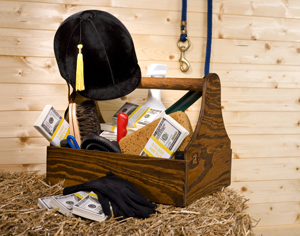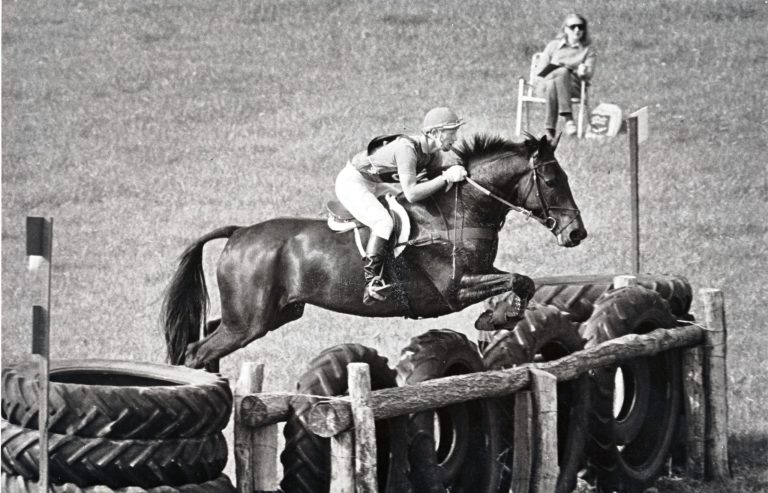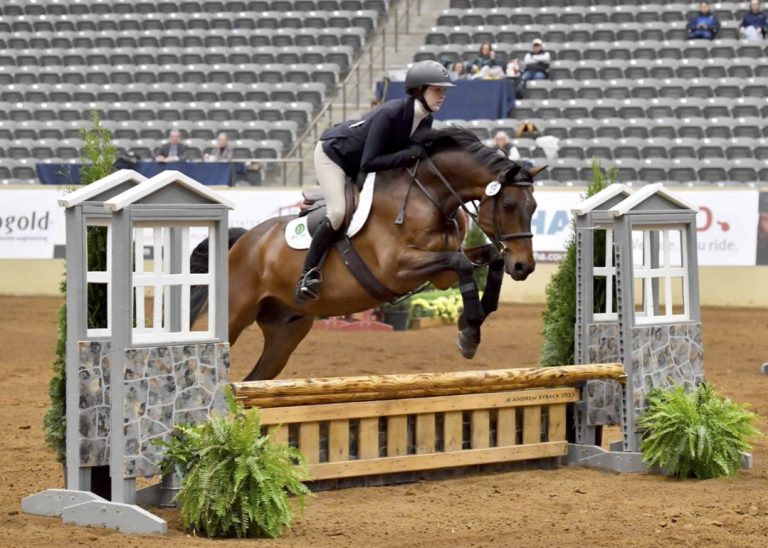
At every level, equestrian sports are costly in both time and money. Those investments can provide nice dividends, however, when it’s time for families to tackle the high costs of college. Riding-related scholarships range wildly: from $500 offered by a local organization to “full rides” from schools with National Collegiate Athletic Association equestrian teams. The full rides (full tuition paid scholarships) are generally offered to only a handful of “blue-chip” recruits each year, but the determined college-bound equestrian, usually with his or her parents’ help, can find cash for college from a variety of sources.
It should be a given that a family’s top priority is to find the right school, regardless of scholarship opportunities, stresses Peter Cashman. He is an executive board member of the Intercollegiate Horse Show Association, riding director at the West Point Military Academy in West Point, New York, and one who speaks from experience: His oldest daughter competes on a college equestrian team, and his high-school-age daughter is likely on that path. Academics, size, location and ambiance are the key factors in narrowing the school choices, he emphasizes. When considering funds provided by a school, investigate scholarship and financial-aid opportunities only after using these criteria to focus on four or five possibilities.
Good grades are even more important than good riding for admission and scholarship prospects at any school. “No school is going to turn down a good student,” Peter notes. “Don’t just rely on your riding. Keep your grades up so you can be an asset to that school.” Compared to many sports, often the more mainstream sports, equestrian has an advantage in that its young athletes are typically also top students. Coaches and admissions and financial aid personnel often consider an applicant who juggles high academics with a demanding sport like riding to be a cut above the competition because that indicates she can handle the challenges of collegiate success.
High-school riders looking to parlay equestrian accomplishments into help with college costs first need to sort scholarship sources into three broad categories. The first two are the universities themselves: either a school with an NCAA team or those with teams that compete in the IHSA system. Equestrian associations, from the US Equestrian Federation to a local riding club, comprise the third category.
Full Rides: Few and Far Between
Getting recruited for an NCAA equestrian team is the best chance for a substantial scholarship. Per NCAA rules, these teams can offer 15 full rides. These cover tuition, student fees, room, board and books. At present, there are 23 universities with NCAA equestrian teams. A few of them, including Ivy Leaguers Cornell and Brown, do not offer any athletic scholarships, as is the tradition with NCAA Division III schools that generally emphasize academics over athletics. Some of these schools comply with NCAA rules, but their teams compete on the IHSA circuit.
Every NCAA equestrian team distributes its scholarship money differently, and very few riders are offered full athletic scholarships. At Texas A&M in College Station, Texas, equestrian head coach Tana McKay estimates that 90 percent of the 65 young women on her team, including hunt seat and Western riders, receive some athletic scholarship money. The amounts range between 10 and 90 percent of a full ride, roughly $31,000 this year (2010-2011) at Texas A&M. That’s for out-of-state students, who comprise the majority of the school’s hunt-seat team.
At another point on the NCAA spectrum of possibilities, the riding team at Division II school Seton Hill, in Greensburg, Pennsylvania, provides scholarships in the amount of three full rides to the small Catholic liberal arts school. That amounts to roughly $100,000 each year for a team of 15 equestrians. “We try to give everybody some piece of the money,” explains graduate assistant and longtime Seton Hill team member Erin Albert. “The more skilled a rider you are, the more money you will be given, but we try to get everybody what they need to be able to come here.”
As with most NCAA teams, scholarship amounts are defined as a percentage of the entire cost of attending the school, rather than a fixed dollar amount. Team members who maintain their grades, perform well for the team and follow school rules can generally be confident in keeping their scholarship money for all four years of their education. An injured rider can usually take advantage of a “medical red shirt” year that allows her to stay on the team even if she can’t ride.
To prevent friction within the team, most coaches and scholarship recipients don’t divulge how much money the athletic department doles out to whom. And the amount of scholarship money available varies from year to year. The more seniors with scholarships who graduate each spring, the more money there is to offer new team members that fall.
Reserve champion in the hunt-seat division at the 2010 NCAA Varsity Equestrian Championships, Auburn University in Auburn, Alabama, is one of the NCAA network’s most proactive recruiters. Of the team’s 38 young women for the 2010-2011 season, 24 (63 percent), received athletic scholarships. Thanks to the aforementioned correlation between good grades and good riding, several receive the equivalent of a full ride when their athletic scholarships are combined with academic scholarships.
For prospective student athletes, there is an “absolute correlation” between performance on the show circuit and how generous a scholarship they will be offered, reports Auburn head coach Greg Williams. Success as a catch rider is a big plus, as the collegiate riding format requires competing on horses owned by the host school. Once they are on the team, performance, leadership and other factors can alter individual scholarships for the following year.
Show-ring success as a Junior rider is not the only way to get NCAA scholarship money, however. Coaches report cases of “walk-on” team members whose performance and role on the team earned them scholarship money in subsequent years. Some schools have summer riding camps at which talented riders of modest means can impress the coaches.
The perks of NCAA team membership are becoming better known, particularly at the elite ranks of the hunter/jumper world. When former top Junior rider Maggie McAlary received recruiting calls in July 2007, she was not planning to continue riding in college, and schools with teams active on the NCAA circuit were not on her radar screen. That all changed with an invitation for an “official visit” to Auburn University. That fall, she was flown to Auburn from her home in New Hampshire and treated to three days on campus. She was hosted by equestrian team riders, taken to a school football game and, in general, given the red-carpet tour of the academic, equestrian and social scenes.
The experience radically altered Maggie’s college plans. Now a junior at Auburn, she remains thrilled with her decision and has encouraged younger friends to follow in her footsteps?to Auburn and on the NCAA equestrian path in general. Two of her friends at trainer Andre Dignelli’s Heritage Farm in Katonah, New York, are now on the Auburn team.
Getting a very substantial portion of Auburn’s $32,000 annual out-of-state costs covered by the school is only one of many perks of riding for an NCAA team. “It’s really a big deal to be a school athlete,” Maggie summarizes. She lives in student-athlete housing, gets early class registration to make sure her schedule fits with early-morning conditioning workouts and afternoon riding practice, and has access to tutoring.
Although NCAA equestrian has been stuck in “emerging sport” status with just 23 participating schools for some time, the programs at several of these universities are thriving. Competition is fierce, and recruiting efforts are on par with those used in higher-profile sports. Five-time NCAA Varsity Equestrian Championships overall winner, University of Georgia in Athens, and other top contenders, including Texas A&M, University of South Carolina in Columbia, and Southern Methodist University in Dallas, Texas, are among the most active recruiters. They have feelers out all year and scouts at the major equitation finals.
In addition to accumulating a great riding and academic r?sum?, equestrians targeting an NCAA scholarship have lots of homework to do. NCAA has myriad rules regarding eligibility and protocol for communication between coaches and prospective student athletes. The website www.varsityequestrian.com is the best place to start this assignment, which savvy students get a jump on during their freshman year of high school.
Schools with IHSA Teams
Universities with teams that compete outside of the NCAA league comprise a much larger pool of possibilities for riding in college. IHSA currently has more than 370 schools. Per the format of the competition, these teams welcome riders of all experience levels. Unlike NCAA in which equestrian is strictly a women’s sport, many IHSA squads welcome men.
“A lot of them don’t offer traditional athletic scholarships like NCAA,” Peter explains. “But a lot offer many ways to help. Whether it’s called ?scholarships,’ ?financial aid’ or ?grants,’ it can add up.”
His oldest daughter, Randi, is a senior at Centenary College in Hackettstown, New Jersey, which tied for second in last spring’s IHSA National Championships. A working-student program there helps defray her college bills, as did her receipt of $1,000 from the Professional Horsemen’s Association and the $1,800 Emily Hilscher Memorial Scholarship. The latter is one of 32 Intercollegiate Equestrian Foundation awards, through which the IHSA last year divvied up $39,600 in scholarship funds.
It’s a mistake to look only for riding-related scholarships, urges Beth Beukema, president of the Intercollegiate Dressage Association and director of equine studies at Johnson & Wales University in Rehoboth, Massachusetts. “You should really be looking at any scholarships the school has to offer.” At Johnson & Wales, for example, any student who was an honor student in high school gets a $10,000 scholarship. “All of our scholarships are purely academic,” she explains. “We are looking for the best students who also ride.”
Completing a Federal Student Aid application (www.fafsa.ed.gov) is the first step for anyone seeking scholarships, grants or financial aid, Beukema notes. “Even if you don’t think you will be eligible, every school will require that.”
Described by Newsweek magazine as one of the 25 “New Ivies,” 2010 IHSA national hunt seat champion Skidmore College has a team of 30 riders. Head coach Cindy Ford estimates that between 40 and 50 percent of them receive some form of financial aid from the school.
Equestrian is one of several sports taken very seriously by the Saratoga Springs, New York, school. As such, the team typically has access to two or three substantial scholarships every year. These are earmarked for Skidmore athletic coaches who have their eyes on an impact player and want to make it more feasible and/or attractive for the student to attend. “This would be an exceptional individual who has a very strong possibility of making the riding team,” Cindy explains.
“If there’s a good rider who I want on my team, I will work with financial aid and admissions and the family to see what help he or she is eligible for.”
Beyond the Schools
Equestrian organizations of all sizes offer college scholarships. The US Equestrian Federation and the US Hunter Jumper Association have long lists of affiliate organizations providing scholarships. None that we found come close to a full ride, but every bit helps.
Accomplishments as a Junior rider netted Californian Karli Postel $5,000 in college funds before she headed off to Goucher College in Baltimore, Maryland, where she’s a top member of the school’s IHSA team. Half of that money came from winning the Los Angeles Hunter Jumper Association’s inaugural Horsemastership Competition in 2006, and another $2,500 was awarded through her region’s Interscholastic Equestrian League for high school riders. When she was a freshman last year, Karli was encouraged by her equestrian coach to apply for one of IHSA’s 32 $1,200 scholarships, which she received.
Scholarships offered by organizations typically require a riding r?sum?, recommendations and an essay. The Interscholastic Equestrian Association’s Zone 4, a high school competition organization, divvied up $2,225 among three college-bound members this year. To judge the essays, IEA enlisted the help of Carol Lee Conchar, regional director of admissions for The George Washington University in Washington, DC.
“I used the same point of view as I do when reading applications for the university,” relayed the judge, who had little prior knowledge of the equestrian world. “I look for good storytelling, the ability to embrace their experience and apply it outside of who they are, and the ability to articulate appreciation for their riding experience as it pertains to the organization providing the scholarship.” This last criterion was most impressive in an essay from a very tall rider who was mounted on a very small pony. “She explained that it was part of the organization’s mission to put riders on equal footing and that she appreciated having to figure out how to conduct herself with those limitations,” Carol explains. Another applicant complained about a similarly inappropriate competition mount. That essay did not earn any points from Carol.
Some schools have matching programs. Georgetown College in Georgetown, Kentucky, matches any funds awarded through an equine organization: a $1,000 award from a local dressage chapter, for example, is treated as $2,000 toward tuition. Professional associations often have college money earmarked for deserving children of their members, and some draw relatively few applicants. This year, about 10 students applied for the California Professional Horsemen’s Association’s four $2,000 scholarships, which were awarded based on grades and need.
NCAA equestrian team hopefuls should note that any scholarship money earned from outside sources will be deducted from whatever the school offers.
The box “Resources for Riding-Related College Scholarships” below on scholarship sources from equestrian organizations is a great place to start your search for help with college costs, but don’t stop there. Ask everybody from your riding coach to your high-school counselor, and network with families of older riders who are now at college.
As Karli’s mother Cindy Postel notes, “There’s a lot of money to be had if you are willing to go through the due diligence. It was certainly worth the time invested.”
This article originally appeared in the December 2010 issue of Practical Horseman magazine.










